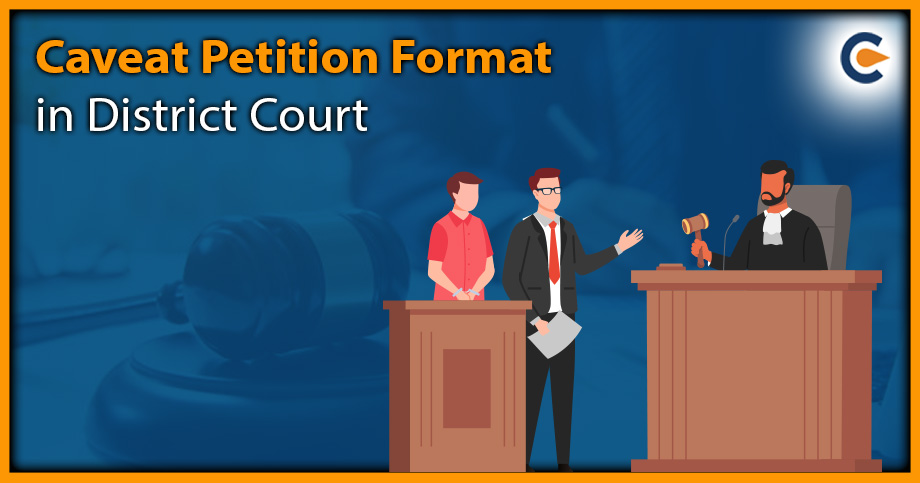A person who anticipates that someone else may file an application in a lawsuit or case that has been or is going to be filed against them may take pre-emptive action by filing a caveat petition. Before any legal action is taken against someone, they are given a formal notice. The person who submits the caveat petition is known as the caveator. In his caveat appeal, the caveator requests that the court inform him if anyone else files an application in a lawsuit or other proceeding against him. The contents and format of a caveat application are discussed in detail in this blog.
Meaning of Caveat
A caveat is a legal notice or warning that is filed with a court or other legal authority to put a party on notice of a claim, interest, or right in a particular matter. In the context of estates, a caveat is a legal document filed with a probate court to prevent the granting of probate or letters of administration in an estate. The purpose of a caveat is to give notice to the court that the person filing the application has an interest in the estate and wants to be notified before any probate or administration is granted.
Caveats are also commonly used in other areas of law, such as property law, where a caveat can be lodged to protect a person’s interest in land or property. In general, a caveat serves as a warning to other parties that they should not take any action that could adversely affect the rights or interests of the party who has filed the caveat without first consulting with them or obtaining their consent.
Format of Caveat Application
A caveator files a caveat application in court to make sure that he is heard before any action is taken against him by the court. The purpose of this application is to protect the interests of Caveator by giving him an opportunity to be heard in the matter pending before the court. The format of a caveat application may vary depending on the jurisdiction and court rules, but generally, it should include the following information:
- Heading: The application should have a heading that includes the name of the court, the probate number (if available), and the title of the document (i.e., caveat application).
- Identification: The application should identify the person filing the caveat and the person against whom the caveat is being filed.
- Grounds for The Caveat: The application should explain why the caveat is being filed. This could be the specific claim, interest or right that the applicant is asserting.
- Relief Sought: The application should state the relief sought that the applicant is seeking to achieve by filing the caveat, which is typically an order that probate or administration not be granted until the caveat is resolved.
- Supporting Documentation: The application should include any supporting documentation or evidence, such as a copy of the will or other relevant documents that may be necessary to support the claim.
- Signature: The application should be signed by the person filing the caveat or their legal representative.
Steps in Filing a Caveat
The basic steps in filing a caveat include:
- Obtain The Correct Form: Most courts will have a specific form for filing a caveat application. You should check with the court or consult with a legal professional to ensure you have the correct form.
- Fill Out The Form: The form will typically ask for your personal information, such as your name and address. Additionally, you will need to explain the grounds for the caveat and the relief sought. Be sure to fill out the form completely and accurately.
- Attach Supporting Documents: You will need to attach any supporting documents to the form, such as a copy of the will or other relevant documents. Make sure to keep a copy of all documents for your records.
- File The Form: Once the form is complete and all supporting documents are attached, you will need to file it with the court. You may need to pay a filing fee, depending on the court and jurisdiction.
- Serve Notice: After filing the form, you will need to serve notice on the opposite party, as well as any other interested parties. The court may provide instructions on how to do this, or you may need to consult with a legal professional.
Documents Needed For Filing a Caveat
The following documents are required while filing a caveat application:
- Filled Index;
- Name of The Court Appealed From;
- Cause Title and Case Name;
- Vakalatnama And Memo of Appearance;
- Court Fees;
- Designation of Authority;
- Date of Impugned Judgment
Conclusion
Under the Civil Procedure Code[1] (CPC), a caveat application is a legal document filed with a court to prevent an ex parte order from being passed in a case where the applicant has a potential interest. The caveat application serves as a notice to the court that the applicant wants to be heard before any order is passed. However, it is important to note that the specific requirements for a caveat application may vary depending on the jurisdiction, and it is always a good idea to consult with a qualified legal professional before filing any legal document.











